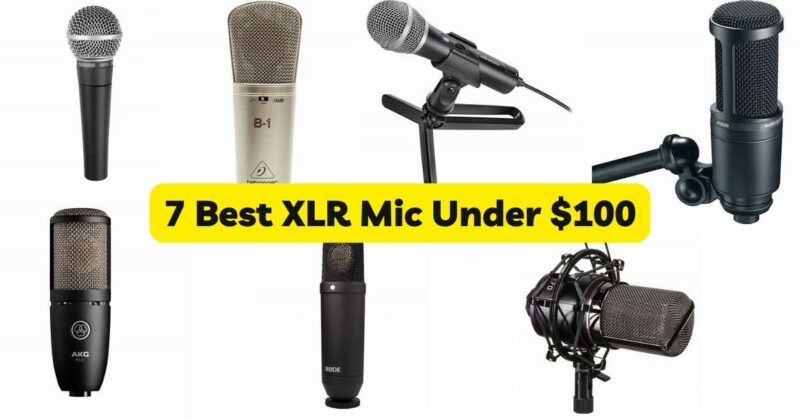When it comes to capturing professional audio recordings or performing live, having a high-quality microphone is crucial. XLR microphones, known for their balanced audio signal and reliable connectivity, are a popular choice among audio enthusiasts, podcasters, musicians, and content creators. While there are plenty of premium options available, you don’t have to break the bank to find a great XLR microphone. In this article, we’ll explore the 7 best XLR microphones under $100, combining affordability and performance to help you make an informed decision.
Here are 7 Best XLR Mic Under $100:
- Audio-Technica AT2020
- Shure SM58
- AKG P220
- Behringer B-1
- MXL 770
- Rode NT1
- Audio-Technica ATR2100x-USB

Pros:
- Affordable price point.
- Excellent sound quality with a wide dynamic range.
- Cardioid polar pattern for focused sound capture.
- Solid build quality and durability.
Cons:
- Requires phantom power from an audio interface or mixer.
- May pick up more background noise compared to dynamic microphones.
The AT2020 offers impressive sound quality with a wide dynamic range. Its condenser capsule captures vocals and instruments with great clarity and detail. It delivers a smooth and balanced frequency response, making it suitable for various recording applications.One of the standout features of the AT2020 is its cardioid polar pattern, which allows it to focus on capturing sound directly in front while minimizing background noise. This makes it ideal for studio recordings where capturing the source accurately is crucial.In terms of build quality, the AT2020 feels solid and durable. Its sturdy construction ensures it can withstand regular use and handling. However, it’s important to note that the AT2020 is a condenser microphone, which means it requires phantom power from an audio interface or mixer to operate. This may be a consideration for users who don’t have access to phantom power or prefer a microphone that doesn’t require it.While the AT2020 excels in capturing vocals and acoustic instruments, some users have reported that it can be sensitive to handling noise. This means that extra care should be taken when positioning and handling the microphone during recordings.
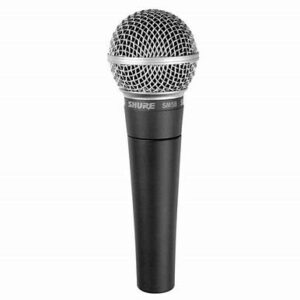
Pros:
- Legendary durability and reliability.
- Excellent vocal reproduction with a presence peak for enhanced clarity.
- Effective cardioid polar pattern for reducing background noise.
- Ideal for live performances and studio recording.
Cons:
- Slightly higher price compared to other options on the list.
- May not offer the same level of detail and sensitivity as condenser microphones.
The SM58 is built like a tank and designed to withstand the rigors of live performances. Its rugged construction ensures it can handle frequent use, rough handling, and even the occasional drop without compromising its performance. This makes it a reliable choice for musicians, vocalists, and public speakers who need a microphone that can withstand demanding environments.One of the standout features of the SM58 is its exceptional vocal reproduction. It has a tailored frequency response that emphasizes the midrange frequencies, resulting in clear and present vocals that cut through the mix. The presence peak in the frequency response adds a nice clarity and articulation to the vocals, making it a popular choice for singers in live settings.The cardioid polar pattern of the SM58 effectively rejects off-axis sound, reducing feedback and minimizing background noise. This allows performers to focus on their vocals without worrying about unwanted noise interference. The microphone also features a built-in spherical wind and pop filter that helps reduce plosive sounds and breath noise.In terms of sound quality, the SM58 provides a warm and rich tone with a good amount of detail. While it may not have the same level of sensitivity and accuracy as condenser microphones, it excels in capturing the natural character and energy of a live performance.It’s important to note that the SM58 is a dynamic microphone, which means it doesn’t require phantom power and is less sensitive to handling noise compared to condenser microphones. This makes it a practical choice for performers who move around on stage or need a microphone that can handle high sound pressure levels.

Pros:
- High-quality condenser microphone.
- Warm and rich sound with a wide frequency response.
- Cardioid polar pattern for focused sound capture.
- Suitable for vocals, instruments, and studio recording.
Cons:
- Requires phantom power from an audio interface or mixer.
- May be more sensitive to handling noise compared to dynamic microphones.
The P220 features a large-diaphragm condenser capsule that delivers a warm and detailed sound. It has a wide frequency response that captures a wide range of frequencies with accuracy and clarity. This makes it suitable for recording vocals, acoustic instruments, and overhead drum miking.One of the standout features of the P220 is its selectable polar patterns. It offers both cardioid and omnidirectional options, allowing you to tailor the microphone’s pickup pattern to your specific recording needs. The cardioid pattern is ideal for capturing sound from a specific direction while minimizing off-axis noise, while the omnidirectional pattern captures sound from all directions equally.
The build quality of the P220 is solid, with a rugged metal body that can withstand regular use. It also includes a shock mount to reduce unwanted vibrations and handling noise during recording sessions. The microphone requires phantom power from an audio interface or mixer, so it’s important to ensure your recording setup can provide the necessary power.In terms of sound quality, the AKG P220 offers a smooth and balanced tone. It captures vocals with clarity and detail, highlighting the nuances of the performer’s voice. It also excels in reproducing the natural resonance and character of acoustic instruments, making it a versatile choice for studio recordings.While the P220 generally performs well, some users have noted that it can be sensitive to plosive sounds and may require additional pop filters or proper mic technique to mitigate this issue. Additionally, some users have reported that the microphone’s shock mount could be more sturdy and reliable.
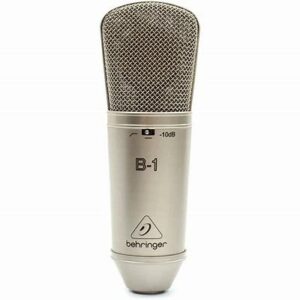
Pros:
- Large-diaphragm condenser microphone with low noise.
- Detailed and transparent audio reproduction.
- Selectable polar patterns for versatile recording options.
- Comes with a shock mount and carrying case.
Cons:
- Build quality may not be as robust as higher-end options.
- Some users report issues with the shock mount.
One of the standout features of the B-1 is its large-diaphragm capsule, which provides a warm and detailed sound reproduction. It captures vocals and instruments with clarity and accuracy, making it suitable for a variety of recording applications such as vocals, acoustic guitars, pianos, and drum overheads.The B-1 features a cardioid polar pattern, which focuses on capturing sound from the front while minimizing off-axis noise. This makes it ideal for isolating the desired sound source and reducing background noise during recording. The microphone also includes a high-pass filter and a -10dB pad switch, allowing you to tailor the microphone’s response to different recording scenarios.
In terms of build quality, the B-1 feels sturdy and durable. Its metal construction ensures it can withstand regular use and handling without any issues. The microphone also comes with a shock mount and a foam windscreen to reduce unwanted vibrations and plosive sounds during recording sessions.The sound quality of the B-1 is generally well-regarded, with a balanced and natural tone. It captures vocals with clarity and detail, reproducing the nuances of the performer’s voice. The microphone also performs admirably on instruments, delivering a faithful representation of their sonic characteristics.While the B-1 offers impressive performance for its price, it’s worth noting that some users have reported a slightly higher noise floor compared to more expensive condenser microphones. Additionally, the microphone may require careful positioning and a controlled recording environment to achieve optimal results.
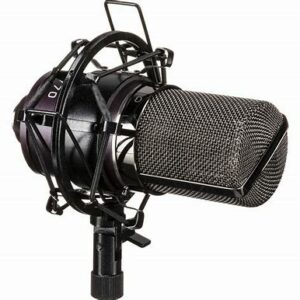
Pros:
- Versatile condenser microphone for vocals and instruments.
- Warm and balanced sound with a wide frequency response.
- Cardioid polar pattern for focused sound capture.
- Includes a shock mount and carrying case.
Cons:
- Requires phantom power from an audio interface or mixer.
- May pick up more room noise compared to dynamic microphones.
The MXL 770 features a large diaphragm condenser capsule that delivers a warm and rich sound reproduction. It has a wide frequency response that captures the nuances of vocals and instruments with accuracy and clarity. This makes it suitable for a variety of recording applications, including vocals, acoustic instruments, and podcasting.One of the standout features of the MXL 770 is its affordability. It offers a budget-friendly option for those who are starting out in home recording or on a tight budget. Despite its low price, the microphone does not compromise on sound quality, making it a popular choice among beginners and home studio enthusiasts.
The build quality of the MXL 770 is solid, with a durable metal body that can withstand regular use. It comes with a shock mount to reduce vibrations and handling noise, ensuring clean recordings. The microphone requires phantom power, so make sure your audio interface or mixer can provide the necessary power.In terms of sound quality, the MXL 770 delivers a smooth and balanced tone. It captures vocals with clarity and detail, highlighting the nuances of the performer’s voice. The microphone also performs well on acoustic instruments, providing a natural and accurate representation of their sound.While the MXL 770 offers excellent value for the price, there are a few considerations to keep in mind. Some users have reported that the microphone can be sensitive to plosive sounds and may require additional pop filters or proper mic technique to mitigate this issue. Additionally, the microphone’s self-noise level is slightly higher compared to more expensive condenser microphones, but it is generally not noticeable in most recording scenarios.
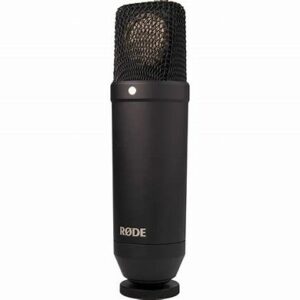
Pros:
- Low self-noise and transparent audio reproduction.
- Detailed sound with a wide frequency response.
- Cardioid polar pattern for focused sound capture.
- Includes a shock mount and pop filter.
Cons:
- Higher price compared to other options on the list.
- Requires phantom power from an audio interface or mixer.
One of the standout features of the Rode NT1 is its impressive sound reproduction. It captures vocals and instruments with remarkable clarity, detail, and accuracy. The microphone features a large diaphragm condenser capsule that delivers a warm and natural sound, making it suitable for a wide range of recording applications, including vocals, acoustic instruments, and podcasting.The NT1 is known for its ultra-low self-noise, which is one of the lowest in its class. This means that even the most subtle nuances and details in your recordings are captured without any added noise or interference. The low self-noise makes the NT1 an excellent choice for capturing vocals and delicate acoustic performances where clarity and precision are crucial.
In terms of build quality, the NT1 is solidly constructed with a durable metal body. It has a sleek and stylish design that exudes professionalism. The microphone comes with a shock mount and a pop filter, which help reduce vibrations and plosive sounds during recording sessions.The sound quality of the NT1 is often described as transparent and accurate. It captures vocals with exceptional detail and naturalness, allowing the performer’s nuances to shine through. It also excels in capturing the full tonal range of acoustic instruments, providing a true representation of their sound.While the NT1 is highly praised for its sound quality and low self-noise, it’s worth noting that it requires phantom power to operate. Therefore, it’s important to ensure that your audio interface or mixer can provide the necessary phantom power.

Pros:
- Dual-purpose microphone with USB and XLR connectivity.
- Suitable for both recording and live performances.
- Cardioid polar pattern and wide frequency response.
- Built-in headphone monitoring and adjustable gain control.
Cons:
- USB connection may not offer the same audio quality as XLR.
- May require additional accessories for XLR connection.
One of the standout features of the ATR2100x-USB is its dual USB and XLR connectivity. This means that you can easily connect the microphone to your computer via USB for digital recording, or use the XLR output to connect it to an audio interface or mixer for analog recording. This versatility makes it a great choice for a variety of recording applications, including podcasting, voiceovers, and live performances.The microphone features a dynamic capsule that delivers a warm and detailed sound reproduction. It captures vocals and instruments with clarity and accuracy, providing a balanced and natural tone. The ATR2100x-USB also includes a built-in headphone jack with volume control, allowing for real-time monitoring and easy adjustment of the audio levels.Build quality-wise, the ATR2100x-USB feels sturdy and well-made. It has a durable metal construction that can withstand regular use and handling. The microphone comes with a tripod desk stand and a pivoting stand mount, providing flexibility in positioning during recording sessions.
In terms of sound quality, the ATR2100x-USB performs admirably for its price range. It captures vocals with clarity and intelligibility, making it suitable for podcasting and voiceover work. The microphone also handles instruments well, delivering a balanced and accurate representation of their sound.One of the key advantages of the ATR2100x-USB is its affordability. It offers excellent value for the price, especially considering its dual USB and XLR connectivity options. However, it’s important to note that the microphone’s sound quality may not match higher-end condenser microphones in terms of sensitivity and frequency response. Additionally, some users have reported that the USB connection can introduce a slight latency, which can be mitigated by using the XLR connection for real-time monitoring.
In conclusion, finding a quality XLR microphone under $100 is not only possible but crucial for achieving professional audio recordings, podcasting, or live performances. Throughout this article, we have explored the importance of investing in a reliable microphone within a limited budget and discussed the key factors to consider when making a choice. We have presented a list of the 7 best XLR microphones under $100, each offering unique features and performance capabilities. These microphones have been carefully selected based on their value for money, build quality, and overall audio performance.However, it is crucial to note that every user’s needs and preferences may vary. Before making a final decision, we strongly encourage readers to conduct further research and consider their specific requirements. Reading user reviews and seeking advice from professionals can provide valuable insights into how each microphone performs in different scenarios.
Investing in a quality XLR microphone, even within a limited budget, is a wise decision. It ensures that you capture clear and professional audio, enabling you to deliver outstanding recordings, podcasts, or live performances. Remember, a high-quality microphone is an essential tool for enhancing the overall audio quality and impact of your work. Take the time to evaluate your specific needs, whether it’s vocal recording, instrument recording, or podcasting. Consider factors such as frequency response, polar pattern, and build quality to find the microphone that best suits your requirements.The right XLR microphone under $100 can make a significant difference in the quality of your audio productions. By investing in a reliable and well-performing microphone, you set yourself up for success. So, continue your research, explore user reviews, and make an informed decision that aligns with your specific needs and preferences. Your journey to exceptional audio starts with the right microphone choice.

